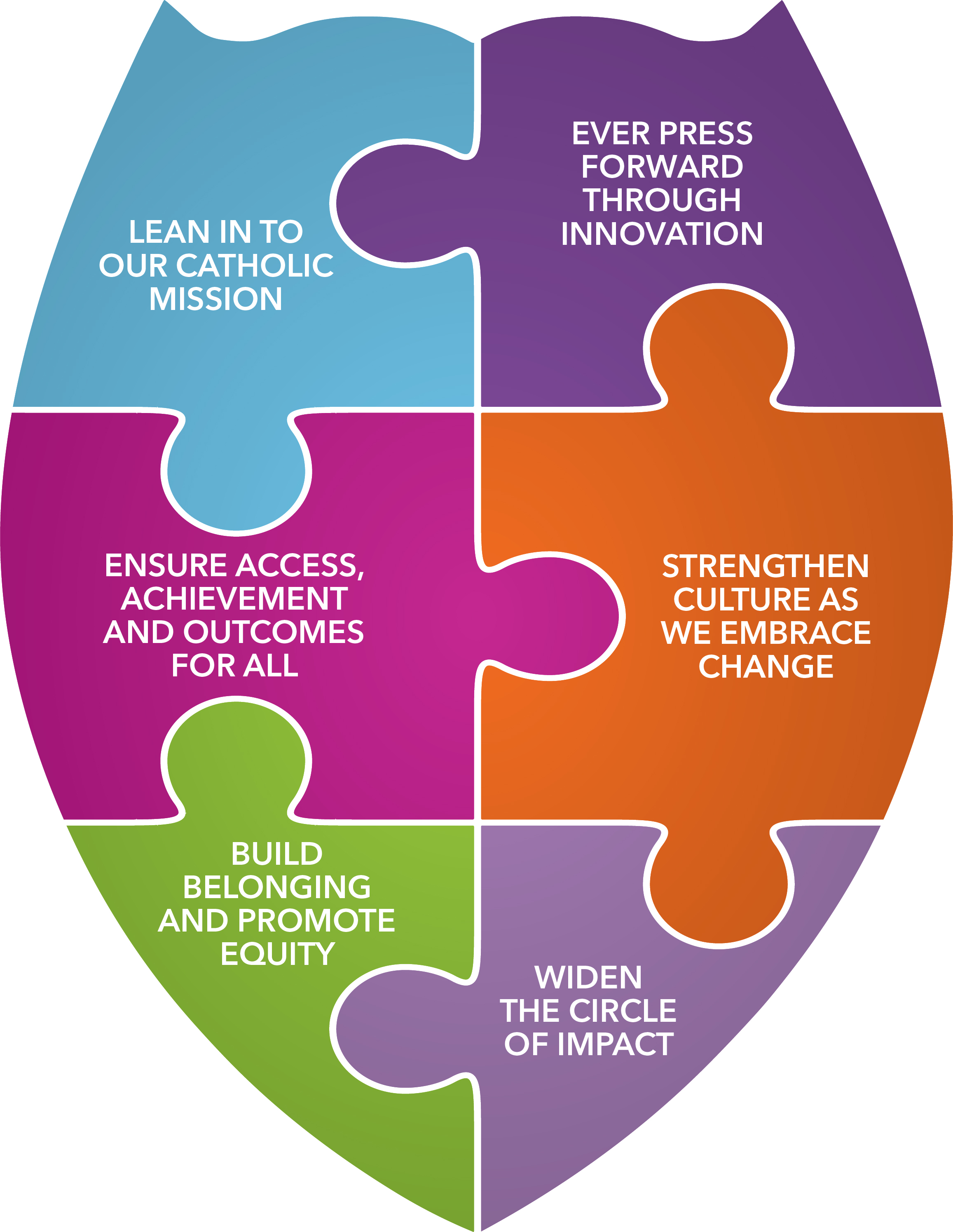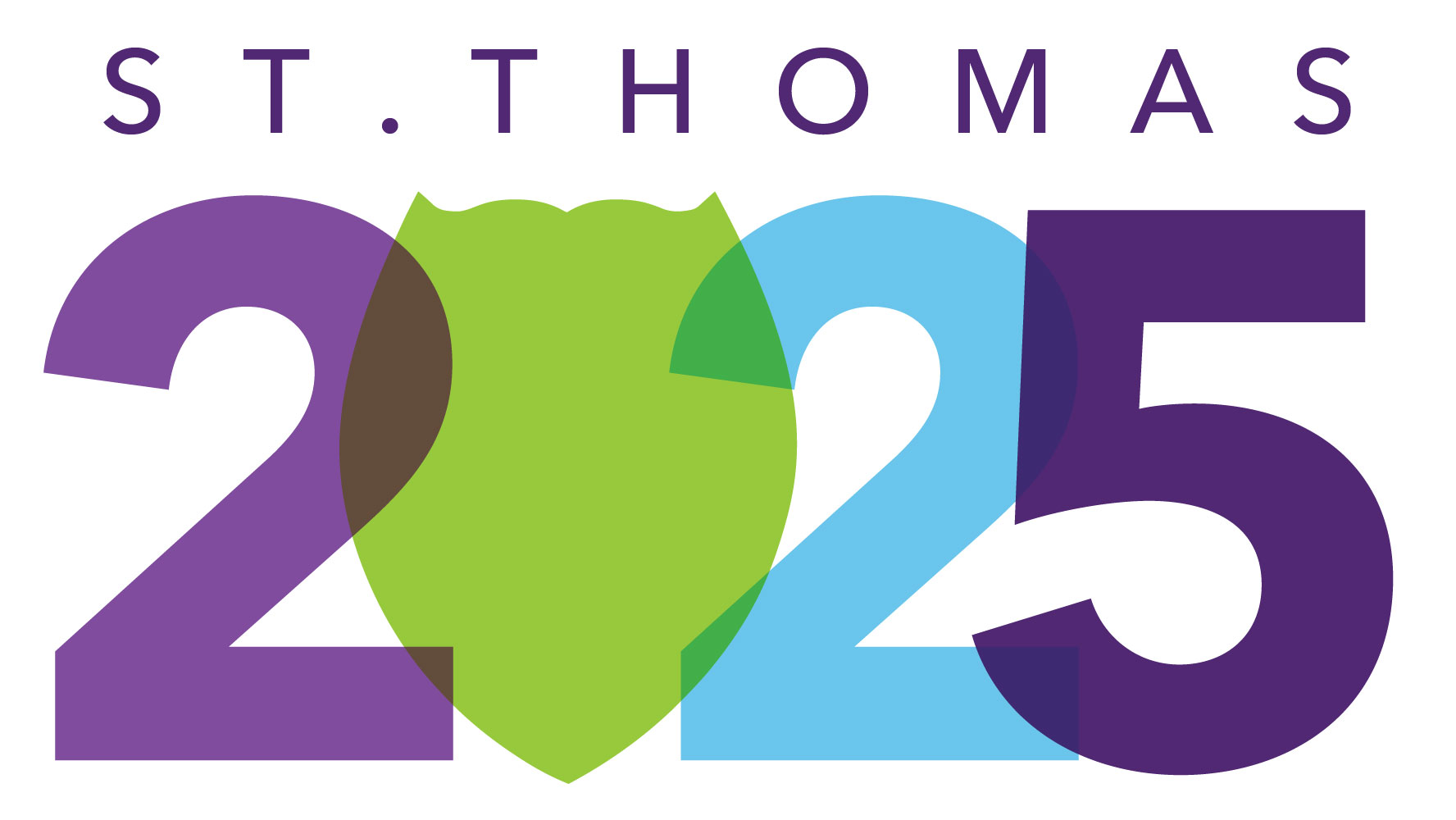With the demographics of college-age students set to undergo radical shifts in the coming years, St. Thomas unveiled this week a bold five-year plan designed to propel the university into the country’s top echelon of Catholic higher educational institutions.
St. Thomas 2025 calls out 16 specific priorities ranging from promoting and leveraging academic excellence to fostering belonging and dismantling racism. While the majority of the 16 priorities represent evolutions of many existing areas outlined in St. Thomas’ previous strategic plan (St. Thomas 2020), this year’s St. Thomas 2025 includes six new and emerging priorities: leading in STEAM education; growing the Morrison Family College of Health; fostering belonging and dismantling racism; meeting ever-changing needs of students, alumni and employers; preparing students for work and career; building national awareness and advancing priorities through athletics.
President Julie Sullivan, who discussed the plan Thursday at the annual State of the University address, said these priorities, formed with community-wide input collected and analyzed by a strategic planning task force, will ultimately help the university thrive in an increasingly challenging and competitive higher education environment.
“We have to reach new audiences and we have to pave new paths. We will innovate,” Sullivan said. “We are driven by our Catholic mission to advance the common good and what we do next will determine the future of St. Thomas for the next 50 years.”
At the center of the plan is a goal to achieve a new 10-year aspiration: advance St. Thomas to the level of excellence, impact and reputation that distinguishes the top 10 national Catholic universities.
“This is the star that we're shooting for,” Sullivan said, adding that the top 10 Catholic universities have higher retention and graduation rates, and more resources devoted to supporting their students. "Thirdly they have a stronger visibility and diversity of draw in terms of where they bring their students from," she said.
“Our ability to maintain the university’s viability depends on us being able to successfully recruit from a broad pool of prospective students," she said. "In the next decade, however, we will face major shifts in demographics of those prospective students.”
Those shifts, which are highlighted in an online St. Thomas 2025 flipbook, include:
- A significant drop in the number of 18-year-olds graduating from high school by 2026 (a trend that is expected to hit the Northwest and Midwest particularly hard)
- Greater economic disparities
- A diminishing population of 18-year-olds who are able to afford a traditional residential experience
- More-racially diverse populations
- A COVID-19 pandemic causing many students to rethink their college choices

President Julie Sullivan gives her 2021 State of the University address.
All of these factors mean St. Thomas must reach students the university hasn’t reached before. Sullivan pointed out that rapidly increasing the racial and geographic diversity of the undergraduate student body and welcoming transfer students will become absolutely essential for St. Thomas.
These factors reflect the concerns and aspirations of the entire St. Thomas community. Overall, hundreds of St. Thomas faculty and staff provided more than 1,900 insights that formed the major topics, themes and priorities. Under the guidance of strategic planning task force co-chairs (Opus College of Business Professor Dr. Katherina Pattit and Vice President for Innovation and Technology Services and Chief Information Officer Dr. Ed Clark), feedback was also gathered from students, the President’s Cabinet, members of the Board of Trustees and various advisory boards representing the schools and colleges.
So how will St. Thomas look different in the next five years to address the trends?
A More Diverse Student Body – and a More Welcoming and Inclusive Environment
The plan calls for the university to increase its percentage of students of color in the total student population to 32% by 2025 (it is currently at 22%). The initiative to Foster Belonging and Dismantle Racism, however, extends beyond numbers. St. Thomas 2025 aims to improve, campus-wide, a sense of belonging for diverse populations, including race, gender, LGBTQIA+, and religion. This is especially important because employers want graduates who understand diversity, equity and inclusion and can work skillfully in dynamic, diverse environments.
More STEAM, and More Morrison Family College of Health
There is growing demand (locally and nationally) for students in STEAM (Science, Technology, Engineering, Arts and Math) and health care fields. In fact, the public demand for health care services will create a renewed critical shortage of nurses. Launching the Morrison Family College of Health’s School of Nursing, which will welcome its first undergraduate and graduate nursing students during this five-year period, will allow St. Thomas to build a steady pipeline straight to employers’ doors. The plan also aims for a 20% increase in certain undergraduate degrees such exercise science and public health, as well as the Bachelor of Social Work. It also aims to have at least 30% of admitted graduate students in professional psychology, social work, and nursing be from diverse and underrepresented backgrounds; and the same for new faculty and staff.
Sullivan also referenced the planned STEAM complex, which anticipates breaking ground in spring 2022 on south campus and opening in January 2024, pending the success of fundraising efforts. The complex will provide world-class space to accommodate intentional enrollment and diversity growth in engineering, health and digital media fields, in close collaboration with arts and sciences programs. It will also attract top faculty from around the country and globe who seek premier STEAM experiences to educate tomorrow’s workforce.
Internships and Career Experience for Every Student
Through its Preparing Students for Work and Career priority, the university aims to deepen the student-alumni connection through the Tommie network of more than 110,000 alumni and strengthen employer and community partner relationships. This will increase experiential opportunities for students and provide stronger lifelong career outcomes for St. Thomas graduates. The plan calls for every student to be equipped with an internship or career experience before graduation and engage in meaningful career planning. In addition, the university seeks to grow the percentage of alumni who are engaged in helping students with their career from 10% to 40% by 2025.
More Impact Through Athletics
St. Thomas 2025 plan calls for the university to increase the geographic diversity of its athletes, as well as the general student body. By 2025, St. Thomas strives to move from 90% of its U.S. students being from Minnesota and Wisconsin to 82% coming from the region.
The goal will be more attainable because of the university’s entrance as Division I this fall after transitioning from the MIAC, providing an opportunity for St. Thomas to raise its national profile. As the newest of the top 20 nationally ranked Catholic universities to join Division I, St. Thomas will emphasize comprehensive excellence to rise even higher among these peers.
Visit the St. Thomas 2025 Website
St. Thomas launched a website that houses a comprehensive view of its strategic plan. The St. Thomas 2025 website allows site visitors to browse the various guiding themes that support the new and emerging priorities.






